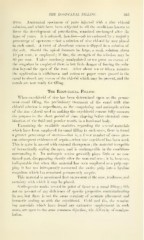Page 465 - My FlipBook
P. 465
THE EOOT-CAXAL FILLING. 463
tives. Anatomical specimens of parts injected with a zinc chloric!
solution, and which have been subjected to all the conditions known to
favor the development of putrefaction, remained unchanged after the
lapse of years. It is advised, therefore—advice endorsed by a majority
percentage of operators—that a solution of zinc chlorid be now placed
in each canal. A twist of absorbent cotton is dipped in a solution of
the salt. Should the apical foramen be large, a weak solution, about
10 per cent., is employed ; if fine, the strength of the solution may be
40 per cent. Unless carelessly manipulated or too great an excess of
the coagulant be employed there is but little danger of forcing the solu-
tion beyond the apex of the root. After about ten or fifteen minutes
the application is withdrawn and cotton or paper cones passed in the
canal to absorb any excess of the chlorid which may be present, and the
canals are now ready for filling.
The Root-canal Filling.
AVhen oxychlorid of zinc has been determined upon as the perma-
nent canal filling, the preliminary treatment of the canal with zinc
chlorid solution is superfluous, as the coagulating and antiseptic action
of the zinc chlorid nsed in making the oxychlorid cement fully answers
the purpose in the short period of time elapsing before chemical com-
bination of the fluid and powder results in a hardened body.
Examining the available statistics regarding the several materials
which have been employed for canal filling in such cases, there is found
a greater percentage of success—that is, a fewer number of cases pres-
ent subsequent evidences of sepsis—when zinc oxychlorid has been used.
This is quite in accord with rational therapeusis ; the material is capable
of hermetically sealing the apex and is unchangeable in the conditions
surrounding it. Its antiseptic action probably jjlays little or no con-
tinued ]iart, disappearing shortly after the material sets it is, however,
;
indisputable that when this material has been employed as a pulp caj)-
ping it has not infrequently converted the entire pulp into a hyaline
coagulum which has remained permanently aseptic.
This material is mentioned first on account of the ease, readiness, and
certainty with which it may be placed.
Gutta-percha ranks second in point of favor as a canal filling ; this
not on account of any deficiency of specific properties contraindicating
its use, but there is not the same certainty of accurate placement and
hermetic sealing as with the oxychlorid. Gold and tin, the remain-
ing materials which have found any extensive employment in such
cases, are open to the same common objection, viz. difficulty of manipu-
lation.


